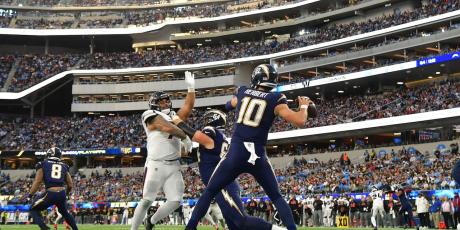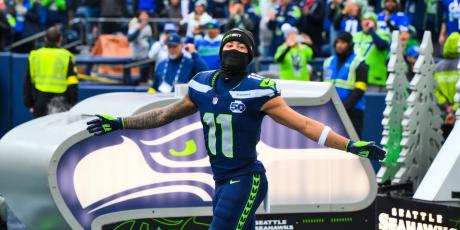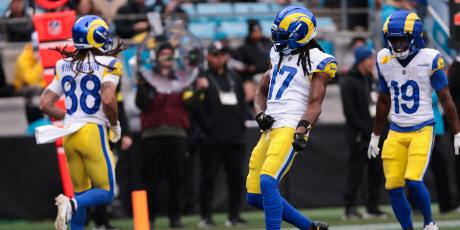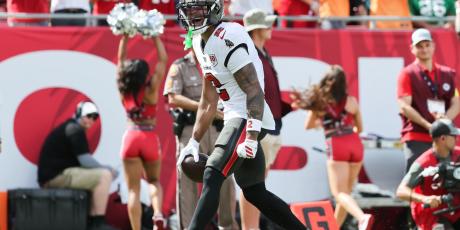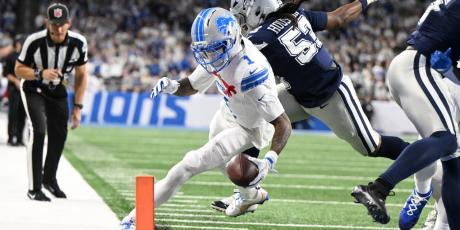The Fantasy Value of Patriots Running Backs Mike Gillislee, James White, Dion Lewis & Rex Burkhead

In 2016, only five teams had more running back fantasy points than the Patriots, who have been in the top-six in four of the past five seasons. But we're on to 2017, where a low-ball contract offer and a rarely used tender essentially smoked LeGarrette Blount out of New England. The Patriots went in a different direction by again poaching one of the few good players on the Bills, Mike Gillislee. Meanwhile, after being drafted as a fantasy RB2 last season, Dion Lewis is now part of the dubious "surprise cut" conversation, and can no longer even be confidently considered his own team's RB2. And in a move sure to utterly perplex Jeff Fisher, the Patriots now have a back with a last name that ends in "head" whose first name isn't "Danny," while James is no longer the team's only White at running back—Rex Burkhead was signed in free agency.
Like so many offenses these days, the Patriots don't feature one running back, opting instead to use a different one depending on whether it's a running or a passing situation. As it currently stands, Gillislee is expected to begin the season as the No. 1 power back, with White as the No. 1 passing-down, or "sub", back.
The Patriots' usage patterns at running back can be unpredictable at times, so how confident can we be in Gillislee and White holding down leading roles? Where does that leave Lewis and Burkhead? And what does it all mean for fantasy?
Subscribe now to 4for4 Classic, Pro, or DFS for 2017!
Mike Gillislee
Having all the looks of an upgrade on fall-back option Blount, Gillislee has a penchant for gaining chunk yardage (no back in the league had a higher percentage of runs go for 15+ yards) and led the league last season in rushing DVOA (min. 100 carries; Blount ranked 18th). In fact, despite inferior offensive line play, Gillislee outperformed Blount in 2016 even when there were more defenders in the box trying to stop him. And because a Tyrod Taylor-led passing game doesn't instill fear in defenses the way a Tom Brady-led one does, Gillislee faced more defenders in the box on a higher percentage of his carries than Blount did.
| RB | YPC vs. 8+ | % of Car vs. 8+ | YPC vs. 7 | % of Car vs. 7 | YPC vs. <7 | % of Car vs <7 |
|---|---|---|---|---|---|---|
| Mike Gillislee | 4.7 | 12.9% | 5.8 | 74.3% | 6.6 | 12.9% |
| LeGarrette Blount | 1.2 | 10.4% | 4.0 | 65.6% | 4.6 | 24.1% |
via PlayerProfiler.com
Despite being listed at 37 pounds lighter, Gillislee (207 pounds) was able to match Blount (245 pounds) last year with 1.2 yards per touch gained after contact. Albeit on a small sample size in Gillislee's case, almost every data point suggests that the analytically-minded Super Bowl champs have acquired a runner in Gillislee that will be better than Blount was.
How Many Carries Will Gillislee Get in Blount's Old Role?
Unlike Blount, Gillislee can stay on the field in every situation -- whereas 85 percent of Blount’s carries came from under center last season, 74 percent of Gillislee’s career carries have come out of the shotgun, the formation where Brady and the offense have been at their best.
Despite Gillislee's added versatility, past history suggests it's not necessarily reasonable to expect the Patriots to feed him 299 carries like they did Blount last season. Gillislee carried more than 58 times in a season just once in four years at Florida, and has carried more than 15 times just once so far in 23 NFL games. Meanwhile, in Burkhead, New England now has a more capable direct backup to Gillislee than it had to Blount (more on that later). Furthermore, the team is likely to go more pass-heavy after last season’s 550 attempts came in at 59 less than its previous five-year low (609 in 2014).
That said, Gillislee is a good bet to handle at least half of the Patriots' rushing attempts in 2017:
| Year | Power Back | G | Tm Rush Att/G in Power Back's GP | Power Back's Rush Att/G | % of Tm |
|---|---|---|---|---|---|
| 2016 | LeGarrette Blount | 16 | 30.1 | 17.6 | 58.5% |
| 2015 | LeGarrette Blount | 12 | 23.7 | 13.8 | 58.2% |
| 2014 | Jonas Gray* | 8 | 26.9 | 11.1 | 41.3% |
| 2014 | Stevan Ridley | 6 | 29.7 | 15.7 | 52.9% |
| 2014 | LeGarrette Blount | 5 | 24.0 | 12.0 | 50.0% |
| 2013 | LeGarrette Blount** | 16 | 29.4 | 9.6 | 32.7% |
| 2013 | Stevan Ridley** | 14 | 30.4 | 12.7 | 41.7% |
| 2012 | Stevan Ridley | 16 | 32.7 | 18.1 | 55.4% |
**The Patriots used their power backs a lot more in 2013 because sub back Shane Vereen managed to appear in only 8 games.
Perhaps most relevantly, Blount’s carry share with Lewis active has been 57.6 percent. Even if we assume that the Patriots' amount of rushing attempts dips to its five-year low (383, in 2015), and that Gillislee’s yards per carry regresses from his career rate of 5.62 to the team's adjusted line yards expectation last year of 4.15, a 57.6 percent share of rushes would still net Gillislee 221 carries for 917 yards. And based on how efficient he's been in the past, there's a lot of wiggle room for him to reach or exceed that yardage projection even if he fails to match Blount's carry share due to Burkhead's presence.
Being a Power Back for the Patriots Means Massive Touchdown Upside
A big benefit to being the Patriots' power back is that their offense is always near the top of the league in play volume inside the opponent's 10-yard line, especially since the team tends to hand the ball off on over half of those plays:
| Year | Plays Ins. 10 | Rank | Rush Play % | Power Back Rush TD |
|---|---|---|---|---|
| 2016 | 98 | 1 | 63.3% | 18 |
| 2015 | 72 | 4 | 45.8% | 7 |
| 2014 | 90 | 1 | 54.4% | 10 |
| 2013 | 76 | 4 | 50.0% | 14 |
| 2012 | 112 | 1 | 58.9% | 12 |
Blount’s 18-rushing-touchdown season was an outlier, but Gillislee is still slated to inherit a role that has produced double-digit rushing touchdowns in four of the last five seasons. And for what it's worth, Gillislee is no stranger to the end zone, having scored eight rushing touchdowns on just 101 attempts in 2016, good for a league-leading 7.92 percent touchdown rate. In fact, Gillislee has outclassed Blount in scoring at every part of the field: While only 30 percent (27-of-74) of Blount's career touchdowns have come on a touch not inside the 10, 41.6 percent (5-of-12) of Gillislee's have, and while Blount has scored on 36.5 percent (27-of-74) of his career carries with the Patriots inside the 10, Gillislee has scored on 58.3 percent (7-of-12) of his career carries inside the 10.
Mike Gillislee's 2017 Fantasy Outlook
Combine Gillislee's conservative yardage projection from earlier (917) with 7 touchdowns and you get 133.7 fantasy points, which would have been the RB25 in standard and the RB37 in PPR last season, before adding in any receiving production (which, due to his shotgun prowess, should be better than Blount's 7-38-0 line last season). Assuming he posts no more than Blount's modest receiving totals from 2016, Gillislee would still have finished as a low-end RB2 in standard leagues and a mid-range flex in PPR leagues last season. But remember, double-digit touchdowns are well within reach, which could catapult Gillislee to RB1 status in all formats, even with a conservative yardage projection.
With ADPs currently at RB25 (Fantasy Football Calculator standard) and RB26 (post-June 15 MFL10 best-ball PPR), Gillislee is being priced closer to his floor than his ceiling (barring injury). All running backs beyond the top 15 or so have workload questions of some sort, but Gillislee has arguably as much upside as any of those backs because of the high-powered offense he plays in. He makes for an appetizing mid-20s fantasy pick at the position.
For Gillislee's most up-to-date ADP, use 4for4's Multi-Site ADP tool.
James White
Despite Bill Belichick's November 2016 assertion that "it would take quite a bit" for anyone (namely, Lewis) to supplant White in the Patriots' backfield rotation, at one point White having a firm grip on his role could have still been written off as recency bias stemming from a monstrous Super Bowl performance. Money talks, however:
-
White’s 2017 extension: 3 years, $12 million, $4.7 million guaranteed
-
Lewis’s 2016 extension: 2 years, $2.6 million, $600k guaranteed
White’s receiving line in nine games without Lewis (3.7-32.0-0.33) was essentially unchanged once Lewis returned for the nine games leading up to the Super Bowl (3.4-32.0-0.33). Lewis didn't even catch more than two balls in any game after his first three games back, averaging 1.6 receptions per game during that span (including playoffs). White, meanwhile, had three or more catches in all but one of those games, averaging 4.1 receptions per game over that span.
Will White Struggle to Match Last Season's Targets?
With Rob Gronkowski back healthy, the addition of Brandin Cooks, and an early-down back in Gillislee that is better-suited for passing situations than Blount was, White, despite having overtaken Lewis, is not a good bet to match his 86 targets or 15.7 percent target share from last season (both second on the team), especially if the Patriots' rate of targeting running backs regresses, which is likely after they did so more than they have in years:
| Year | Pass Attempts | RB Targets | RB Target Share |
|---|---|---|---|
| 2016 | 550 | 130 | 23.6% |
| 2015 | 629 | 143 | 22.7% |
| 2014 | 609 | 109 | 17.9% |
| 2013 | 629 | 116 | 18.4% |
| 2012 | 641 | 84 | 13.1% |
| 5-Year Avg. | 611.6 | 116.4 | 19.0% |
Given their new compliment of weapons, it’s completely reasonable to think the Patriots could regress to their 19.0 percent five-year average target share for running backs this season, or dip even lower.
If White gets 59.7 percent of his team's running back targets this season like he did over the final seven-game run to the Super Bowl last season, he would project for 62-72 targets—down 14-24 from 2016 -- depending on how much the Patriots throw. Assuming he performs in line with his career efficiency (72.4 percent catch rate, 6.79 yards per target, 6.2 percent touchdown rate), White would post 45–52 catches, 424–494 yards, and 3.9–4.5 touchdowns on that amount of targets.
White's Lack of Rushing Opportunities Limit His Consistency and Upside
Despite two scores on six carries in the Super Bowl, it’s unlikely White racks up much rushing production in 2017. His career high in carries is seven, and he's never averaged more than 3.0 per game. Belichick has hinted as much, explaining that White's sub back role is clearly defined as that of a pass protector and receiver. At White's (subpar) career yards per carry average of 3.7, he would tally 178 rushing yards on 3 carries per game. Even if he matches his Super Bowl workload and gets 6 carries per game, that puts him at only 355 rushing yards over a full season.
White's lack of a rushing pedigree hurts him in fantasy—even though he was getting consistent receiving usage last season, he was still a volatile scorer:
| NE RB | PPR Pt CV | Rank (Min. 50 Pts) |
|---|---|---|
| LeGarrette Blount | 53.4% | 14/71 |
| Dion Lewis | 64.4% | 32/71 |
| James White | 71.5% | 41/71 |
CV = Coefficient of Variation, or standard deviation divided into mean (lower = more consistent).
Because Gronkowski missed eight games and Martellus Bennett was hobbled for much of last season, White was often the second-best matchup on the field for Brady to exploit. Health of the rest of the receivers permitting, White will be no better than the fourth-best option in 2017. A mix of elite quarterback play, smart play calling, and White's own talent will likely lead to him putting up a few big games, but my guess is as good as yours as to which weeks those games will occur.
James White's 2017 Fantasy Outlook
Given a target expectation in the low 60s to the low 70s, and anywhere from 3–6 carries per game, if White performs at his baseline career efficiency we can expect roughly anywhere from 128–164 PPR points and 83–112 standard points. That would have been good for a RB24–RB38 finish in PPR and a RB29–RB45 finish in standard in 2016.
Treating White as if he'll finish on the low end of that range of outcomes (PPR low-end flex/standard RB4) makes the most sense, not just because of the risk that Patriots running backs sink to their 2012 target share, or because of the team's crowded backfield, but because White will likely be used as a matchup-based threat that will be tough to predict on a weekly basis.
White is best suited for best-ball leagues, where his post-June 15 MFL10 ADP of RB40 is palatable. However, he does have room to beat his current Fantasy Football Calculator ADPs of RB44 (PPR) and RB51 (standard), albeit with not much upside barring mass injuries to the offense's other weapons.
For White's most up-to-date ADP, use 4for4's Multi-Site ADP tool.
Dion Lewis
While Lewis had a fourth-round ADP in PPR formats as late as last season, White's emergence, Lewis’s declining receiving usage, the addition of two versatile backs in Gillislee and Burkhead, and even Lewis's paltry contract relative to White's are all reason for pause when it comes to Lewis's 2017 fantasy prospects.
Lewis Will Be Second in Line for Carries and Receptions—but How Many?
Almost certainly because White is a better pass blocker, Belichick doesn't appear to be comfortable with Lewis in the sub back role, stating that Lewis is not "really a sub back," although he "could do some of those things." The coaching staff obviously wants to get the ball in the shifty Lewis's hands (he started returning kickoffs down the stretch last season), but they have been more inclined to do so in the running game while keeping White in the sub back role:
| NE RB | Rush Att/G | NE RB | Targets/G |
|---|---|---|---|
| LeGarrette Blount | 15.1 | James White | 6.0 |
| Dion Lewis | 8.9 | Dion Lewis | 3.6 |
| James White | 1.8 | LeGarrette Blount | 0.3 |
Despite White (5-foot-9, 204 pounds) being a larger human than Lewis (5-foot-7, 193 pounds), the Patriots showed more willingness to run Lewis even when the defense didn't remove a defender from the box (Lewis faced a base front on 50 percent of carries, while White faced a base front on just 38.5 percent of carries). The coaching staff's reluctance to use White as a runner likely ensures Lewis will be second in line for carries.
In fact, one of the best-case scenarios for Lewis would be a repeat of Weeks 15–17 last year:

via 4for4's Player Snap App

via 4for4's Player Touches App
Fifteen carries per game won't happen for Lewis over a full season, because the Patriots won't rush on 52.4 percent of their plays like they did in the last three weeks of 2016, but Lewis optimists have to hope he can still get on the field roughly one-third of the time and approach double-digit touches each game. While active, Lewis handled 30 percent of the team's rushing attempts last season, and if White indeed has earned roughly a 60 percent share of the team's targets to running backs via the sub back role, Lewis will likely top out at 30 percent of the team's targets to running backs as well. (We also have to take into account the possibility that even if White were to get injured, Lewis's role could remain largely unchanged while Burkhead, who is also a better pass protector than Lewis, takes on the sub back role.)
Dion Lewis' 2017 Fantasy Outlook
Ultimately, we can realistically project Lewis for 7-10 rushing attempts and just over 2 targets per game. Given his career efficiency with New England (4.4 yards per carry, 72.2 percent catch rate, 6.51 yards per target, 2.4 percent touchdown rate), Lewis would post roughly 1.6 receptions, between 45–60 total yards, and 0.2–0.3 total touchdowns per game.
Of course, those rates come from a combination of seven games in 2016, when he averaged 0.68 PPR points per touch (56th of 73 running backs, min. 50 touches), and seven games in 2015, when he averaged 1.41 PPR points per touch (3rd of 86). Assuming Lewis's efficiency lands somewhere between his stellar 2015 and underwhelming 2016, he could average up to 10.0 PPR points per game if his usage hits the top range of outcomes, but no better than 7.0 points per game if it hits the low end, with the wide range of per-touch efficiency he's displayed over the past two seasons pulling his floor even lower and raising his ceiling even higher.
It's probably best to give more weight to a conservative projection of Lewis, however. His peak efficiency happened two years ago, before a torn ACL, and was already an outlier relative to the rest of the league. And despite the general unpredictability of injuries, Lewis's injury history has to be taken as a negative when considering his fantasy value—he has been able to suit up for only 14 of 32 regular season games as a Patriot, and only 38 of a possible 96 since being drafted in 2011.
So while there's an avenue for Lewis to be a viable flex option even if he technically does not play ahead of White or Gillislee, that would be a pretty optimistic outcome. More realistically, Lewis will mix a floor of close to zero points with a couple of blowup games (like his three-touchdown eruption in the 2016 divisional round against Houston). Unfortunately, those big games could be even harder to predict than White's.
While unpredictable blowup potential would in theory make Lewis well-suited for best-ball leagues, his appeal in that format is compromised by an injury history too exorbitant to ignore, not to mention the risk of his role remaining unchanged even if White were to go down. Thus, Lewis's MFL10 ADP of RB66 as of June 15 is fair—he's best served as an RB6 on teams that go with that many.
In standard or PPR leagues, Lewis is best viewed as a potential hot waiver wire pickup to monitor, or perhaps a stash-worthy dart throw in deeper leagues.
For Lewis's most up-to-date ADP, use 4for4's Multi-Site ADP tool.
Rex Burkhead
As hot take-worthy as it may have sounded when Burkhead first signed, it's doubtful he was ever truly in the running to be the Patriots' featured power back. Because Burkhead was signed before the team acquired Gillislee or made a decision on Blount, it seemed at the time like Burkhead would take over Blount's old role, a perception undoubtedly enhanced by recency bias caused by Burkhead's 29-touch, 144-yard, 2-touchdown outburst against the Ravens in the final week of 2016. However, while Burkhead's skill as a runner (he finished first in DVOA among running backs that missed the 100-carry threshold) is surely a big reason the Patriots signed him, it doesn't tell the whole story.
Burkhead Can Play All Running Back Roles, but Special Teams Key
The Patriots likely envision Burkhead's rushing ability as an upgrade on a player they utilize in an unsexy fantasy role: Brandon Bolden.
Keeping in mind roster management of late that could arguably be considered brilliant, it's highly likely the Patriots would rather use a roster spot on the multi-talented Burkhead, who played 209 special teams snaps last season, than on the one-dimensional Bolden, a special-teams ace that the coaching staff has been increasingly reluctant to use on offense (only 13 snaps in 2016)—perhaps due to his declining play starting in 2014:
| Year | G | Car/G | Yds/Car | Tar/G | Yds/Tar | ST Snaps/G |
|---|---|---|---|---|---|---|
| 2012 | 10 | 5.6 | 4.9 | 0.2 | 5.50 | 16.5 |
| 2013 | 12 | 4.6 | 4.9 | 2.4 | 5.24 | 12.7 |
| 2014 | 16 | 1.8 | 3.2 | 0.4 | 1.33 | 17.8 |
| 2015 | 15 | 4.2 | 3.3 | 2.0 | 6.00 | 17.5 |
| 2016 | 14 | 0.1 | 4.0 | 0.3 | 3.75 | 18.9 |
Over the past three seasons, Bolden has averaged just 3.26 yards per carry on 92 carries, and is now owed only $50k guaranteed. Compared to Bolden, Burkhead would be an able replacement on special teams and a huge upgrade at running back, where his size (5-foot-10, 214 pounds) will enable the Patriots to use him in the power back role, while his pass-catching/blocking acumen will enable them to also use him in the sub back role. (He can also play slot receiver.)
Rex Burkhead's 2017 Fantasy Outlook
Burkhead will be a valuable real-life player for the Patriots from the jump, but barring something unforeseen, he'll begin the year as the team's fourth-most valuable fantasy running back, and will likely need an injury to Gillislee or White to come into value.
Like Lewis, Burkhead is a name to monitor in traditional re-draft leagues as a potentially valuable waiver pick-up, or perhaps as a roster stash in deep leagues.
As far as best-ball, Burkhead is going ahead of Lewis in MFL10s (RB60 as of June 15), which is fair only because Burkhead has more power-back upside and doesn't carry a checkered injury history.
For Burkhead's most up-to-date ADP, use 4for4's Multi-Site ADP tool.
Subscribe now to 4for4 Classic, Pro, or DFS for 2017!
- Stop Taking Adrian Peterson Over Mark Ingram in Fantasy
- Danny Woodhead Had RB1 Upside at This Time Last Year - Does He Still?
- Rushing Expectation: Isaiah Crowell & Duke Johnson
- Using Red Zone Expected Value to Find 5 Running Back Touchdown Regression Candidates
- What are the Most Predictable Year-to-Year Stats for Running Backs?







